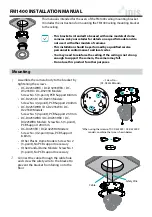
PNI Sensor Corporation
Doc #1016102 r03
RM3000-f & RM2000-f Sensor Suite User Manual
– August 2012
Page 22 of 42
a comparator internal to the 3D MagIC. The sensor’s inductance varies with respect to the
magnetic field. As such, the frequency of oscillation of the circuit varies with the strength of
the total magnetic field parallel to the sensor. To make a measurement, one side of the
sensor is grounded while the other side is alternately driven with positive and negative
current through the oscillator. The circuit is driven for a user-specified number of circuit
oscillations (cycle counts), and the time to complete the specified number of cycle counts is
measured using the 3D MagIC’s internal high-speed clock. The 3D MagIC next switches the
bias connection to the sensor and makes another measurement. The side that was previously
grounded is now charged and discharged while the other is now grounded. Because:
the total magnetic field represents the sum of the external magnetic field and the cir-
cuit-induced magnetic field, and
the circuit-induced magnetic field has the same magnitude but opposite direction for
the two bias polarities,
the external magnetic field is proportional to the difference in the time to complete the user-
defined number of cycle counts. The difference in the number of clock oscillations between
the forward and reverse bias directions is output from the 3D MagIC, and this number is
directly proportional to the strength of the local magnetic field in the direction of the sensor.
Note only one sensor can be measured at a time and the number of cycle counts is
individually set for each sensor. Also, the greater the number of cycle counts, the higher the
resolution of the measurement (to the noise limit) and the longer the sample time. Figure 4-2
provides a detail of the biasing circuit. For more on PNI’s magneto-inductive technology,
refer to the “Magneto-Inductive Technology Overview” white paper found on PNI’s website.
Figure 4-2: LR Oscillator Circuit Biasing Diagram
Since the Geomagnetic Sensor Suite works in the frequency domain, resolution is cleanly
established by the number of cycle counts. Also, the output from the 3D MagIC is inherently
digital and can be fed directly into a microprocessor, which eliminates the need for signal
conditioning or an analog/digital interface between the sensor and host processor.















































